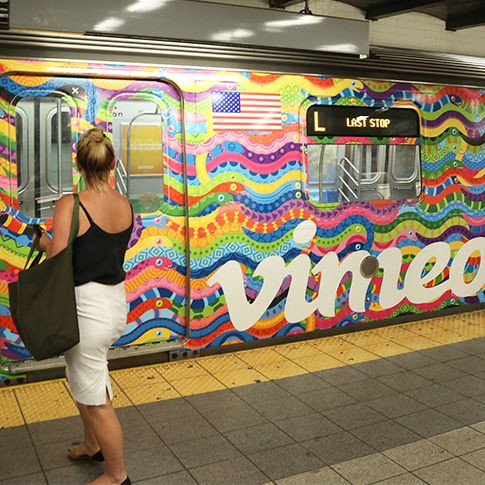Outfront Media Inc. (NYSE: OUT) CEO: Billboards Will Soon Track Smart Phones And Send You Messages

The $1.5 billion company once known as CBS Outdoor got a new name, Outfront Media, and started trading Thursday under ticker symbol NYSE:OUT on the New York Stock Exchange. It’s the latest move for one of the world’s largest outdoor advertising businesses, spun off from CBS earlier this year. We jumped on the phone with CEO Jeremy Male to talk about the new tech coming to billboards on a highway, bus or public space near you.
IBTimes: Aside from the fact you’re not part of CBS anymore, why change the name?
Jeremy J. Male: We are in the out-of-home business and in the transportation business. In New York City we have the selling rights for the subways, buses and Long Island Railroad. As of now, we generate $1.5 billion in revenue from the out-of-home media business. But... the media landscape is changing and we see out-of-home becoming more integral to the broader media ecosystem. We didn’t want to limit ourselves in the future with the “outdoor” tag.
IBTimes: The Web has fractured audiences and ad dollars, disrupting TV, publishing and radio. Are billboards getting disrupted?
Male: We talk about ourselves as the last mass medium; you can still reach 85 percent of the U.S. through our panels. On the other hand, you can drill down to a panel on 33rd Street. As you layer incremental data sets onto our current audience platforms, we will be able to give far more data about our individual audience and their personalities.
IBTimes: Do you see billboards tracking cell phones through beacons or other technologies?
Male: We are now in a position to say what phones pass what billboards. At some point in the future, you could message these phones. It would have to be opt-in. Then you could measure those phones after and see if a behavior has changed. The technology is there right now.
IBTimes: New York City will begin offering municipal Wi-Fi -- do you see billboard companies getting involved in that?
Male: We do have a lot of real estate that is to some extent already being used by Wi-Fi providers. The Wi-Fi-in-New York thing is going to be an interesting development when it rolls out. I think it shows how out-of-home can be beneficial to residents of a municipality. The outdoor media on subway cars creates an interesting environment and generates dollars for the MTA that would otherwise come from subsidy. The new bus shelters all came from ad dollars.
IBTimes: Do you see bike share expanding through advertising?
Male: We work on the bike-share program in Washington, D.C., and Austin [Texas]. If you look nationally, there are a lot of other significant examples. Paris has 22,000 bike stations, all financed by out-of-home media. When you look at it, you’ve introduced a whole new transit system.
IBTimes: What’s the future of smart billboards?
Male: I think as we go forward the connectivity between the consumer and our industry is going to change dramatically. There will be swipe, click and buy. That device, whatever it is, is going to become increasingly about messaging but also about generating data about individuals passing our boards that will help give them a personality. The subway audience is very different between 7 a.m and 9 a.m. than during the middle of the day.
IBTimes: Were you surprised to see Google rent the giant new billboard in Times Square?
Male: It's less surprising to us because tech companies have increasingly turned to out-of-home. Apple is the largest billboard advertiser in the U.S. Samsung is a major user of out-of-home advertiser in the U.S. and worldwide. In every airport, you see Samsung is dominant.
© Copyright IBTimes 2024. All rights reserved.












